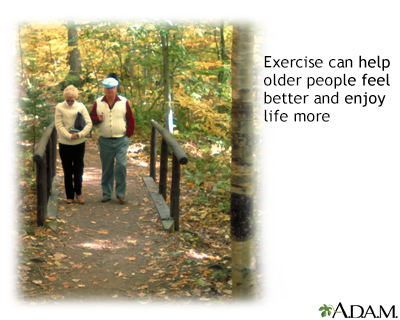| Step 9: Exercise and physical therapy |
Exercise and physical therapy can help in many ways. If you see a physical therapist and learn to exercise properly, you will recover faster and your back pain is less likely to happen again. Physical therapy and exercise help you accomplish these important goals by:
- Teaching you better posture
- Making your back stronger and more flexible
- Getting you back to work sooner
- Making it easier for you to resume normal home and social activities
- Assisting you in losing weight
- Showing you how to avoid falls (especially important for those with a narrow spinal column, called spinal stenosis)
- Helping you feel better about yourself
What type of exercise is best?
Stretching and strengthening exercises are important in the long run. However, starting with these types of exercises too early can make your pain worse. For this reason, it is usually best to begin with light cardiovascular training. Walking, riding a stationary bicycle, and swimming are great examples that you can start as soon as two weeks after your symptoms began. Such aerobic activity can help blood flow to your back and promote healing. They also strengthen muscles in your stomach and back.

Working with a physical therapist is very useful to guide your recovery. The physical therapist will help you determine when it is safe to do these different types of exercise.
Exercise that you shouldn't do
Avoid these exercises during initial recovery unless specifically instructed by your doctor or physical therapist:
- Jogging
- Contact sports
- Racquet sports
- Golf
- Dancing
- Weight lifting
- Leg lifts when lying on your stomach
- Sit-ups with straight legs (rather than bent knees)
What will the physical therapist do?
At first, the physical therapist will try to reduce your pain and inflammation by using methods like:
- Gentle stretching and manipulation
- Ice
- Heat
- Ultrasound
- Electrical stimulation
When the therapist performs ultrasound, a probe with jelly is rubbed over your skin in the area of your pain. Sound waves are transmitted through the probe. The sound waves penetrate to your tense muscles to help them relax.
For electrical stimulation, the therapist places electrodes around the area of your pain. Tiny pulses of electricity are sent through the electrodes. Like the sound waves from ultrasound, the pulses of electricity enter your painful, tense muscles, helping them relax and feel better. By raising the intensity (strength) of the electricity very slowly, the therapist has you direct how much of the pulsations you can take. It doesn't hurt because you tell the therapist to stop before it feels painful or to back down when it feels slightly uncomfortable.
The physical therapist will also teach you how to move correctly in order to avoid twisting, bending, and lifting improperly. When your back is strong enough, you will be taught stretching and strengthening exercises to avoid getting back pain again.
|
Review Date:
6/29/2011 Reviewed By: Andrew W. Piasecki, MD, Camden Bone and Joint, LLC, Orthopaedic Surgery/Sports Medicine, Camden, SC. Review provided by VeriMed Healthcare Network. Also reviewed by David Zieve, MD, MHA, Medical Director, A.D.A.M., Inc. |
